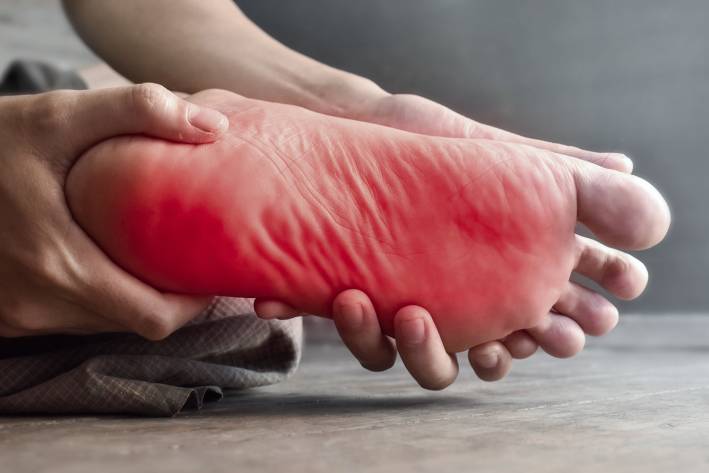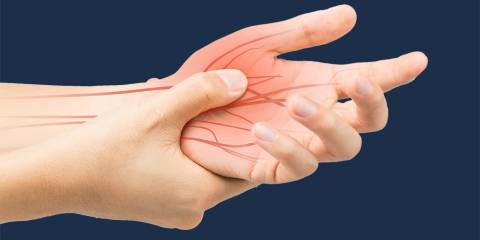Have you ever been sitting on the sofa, riveted by a movie, and find when you get up to get popcorn that your foot is asleep?
It feels prickly, even partly numb, or it can even be a bit painful as you limp around trying to restore circulation.
That is a tiny bit like neuropathy.
What is Neuropathy?
When you examine the root words for “neuropathy,” you will find that it means “nerve disease” or “nerve suffering.”
Our nerves communicate signals in our body, such as take a step or reach out your hand. They also carry communication back from our touches regarding perception—the doorknob is cold, the knife is sharp.
When nerves are inflamed, damaged, and/or blocked, uncomfortable signals can be generated and cause a lot of distress.
Symptoms of Nerve Damage
Nerve pain runs the gamut from irritating to excruciating. If the nerve damage is severe, it may cause a total lack of sensation.
Losing sensation sounds better than pain, but it is dangerous. If you cannot feel the cut on your foot, you may let it go until it is infected or even life threatening. Lack of sensation disrupts your balance and can cause serious falls.
Types of Neuropathy
There are four types of neuropathies, each named for the area they affect.
The best known is peripheral neuropathy, which affects millions of people in the US.
We see peripheral neuropathy in areas of the body that have challenging circulation, farthest from the heart, like the lower leg and foot, though sometimes hands and fingers can be affected.
Causes of Neuropathy
Neuropathies can develop from:
- drug toxicity (chemotherapy)
- nutritional deficiencies
- autoimmune conditions
- circulatory disorders
- traumatic injuries
- infections
- metabolic conditions
- diabetes
Unfortunately, nerves are one of the slowest tissues in the body to repair. Peripheral nerves regrow at a rate of only one inch or less per month. The process of nerve regrowth is impaired even further by chronic and inflammatory conditions, like diabetes.
Diabetes
The most common cause of peripheral neuropathy is diabetes. In fact, it is estimated that over 40% of people with diabetes will develop diabetic peripheral neuropathy, which is the most common complication associated with diabetes.
The abnormally high level of sugar in the blood stream is irritating to the nerves and can cause inflammation. High blood sugar also inflames blood vessels, especially the tiny capillaries, and impedes circulation to the nerve tissue, cutting it off from oxygenation and nourishment.
The best thing you can do for diabetic peripheral neuropathy is to keep your blood sugars as close to normal as possible at all times.
Nutrients to Fight Neuropathy
There are nutrients that have been shown to play an important role in prevention and treatment of neuropathies, and that can improve nerve health, repair, and function.
-
Alpha Lipoic Acid (ALA)
Alpha lipoic acid is a potent antioxidant that has been clinically studied for its positive impact on diabetic neuropathy. ALA is unique because it can neutralize free radicals that are water and fat soluble, offering ideal protection for the nerves from oxidative damage.
In a 2018 study, patients were given 600 mg per day of alpha lipoic acid for 40 days. Patients were scored on their neuropathy symptoms, pain, quality of life, and disability levels. There were significant improvements in all parameters measured.
There was:
- a 58% reduction in people experiencing burning
- a 41% reduction in people experiencing painful coldness
- a 60% reduction in people feeling electric shock
- a 46% reduction in people experiencing tingling
- a 58% reduction in people feeling pins and needles
- a 50% reduction in people experiencing numbness
Plus, half of the patients felt their health condition was “very much better” or “much better” at the end of the study.
Another study on alpha lipoic acid demonstrated that 600 mg twice per day increased peripheral insulin sensitivity in people with type 2 diabetes, which is important with diabetic neuropathy.
-
B Vitamins
Research demonstrates that deficiencies in B vitamins, especially B1, B6, and B12, can lead to neuropathy. The use of these vitamins to treat neuropathy can be found worldwide.
Studies
A combination of these B vitamins was studied for its effects on symptoms of peripheral neuropathy. Improvements were noted after just 14 days of use.
Patients were given 100 milligrams (mg) of vitamin B1, 100 mg of vitamin B6, and 5000 mcg of B12 once per day for 12 weeks.
At the end of the study, the participants noticed a 55.9% average reduction in numbness, 64.7% average reduction in stabbing pain, over 80% reduction in burning pain, and a 62.9% reduction in total symptom score. Subjective feelings of pain also reduced by over 69%.
-
Thiamin
There is a fat-soluble form of thiamin (vitamin B1) that is better absorbed and that stays active in the blood stream much longer called benfotiamine.
A study on this interesting vitamin form found that 200 mg (50 mg dosed four times per day) significantly reduced neuropathy scores in three weeks.
Participants also experienced a significant reduction in their pain.
-
Folate
It has also been found that folate deficiency increases the risk of peripheral neuropathy, especially in people less than 40 years old.
Folate deficient people (folate levels less than 6.8 nmol/L) under 40 are 83% more likely to have peripheral neuropathy than those of a similar age who are folate sufficient (folate levels >13.6 nmol/L).
The methylfolate form of folate is a better supplement than folic acid, as it does not have to be converted in the liver.
Many people are not good at converting folic acid to folate, especially older adults and those with metabolic disorders such as diabetes.
Medications and B Deficiency
Another cause of neuropathy is from medications, like statins that are used to lower cholesterol.
Please remember that I am not encouraging or discouraging the use of medications. That is a discussion for you to have with your healthcare practitioner. I am saying that you need to think about nutrient supplementation if you are currently on these kinds of drugs.
-
Statins
One study found that there is up to a 14-fold increased risk in developing neuropathy for people taking statins versus people not taking statins.
For those on statins, the neuropathy may or may not be reversible, depending upon when it’s diagnosed.
When statins were combined with niacin (vitamin B3), there was more than a 3-fold reduction in development of neuropathy.
-
Metformin
Another drug that can cause vitamin B issues is metformin. People using metformin for type 2 diabetes are more likely to be vitamin B12 deficient, and that risk increases about 13% each year a person takes metformin.
-
-
Minerals and Herbs
-
Zinc
Zinc deficiency has also been implicated in the development of peripheral neuropathy.
One of the mechanisms involves oxidative damage to lipids and other molecules in the body. People with type 2 diabetes and zinc deficiency have decreased nerve conduction in motor and sensory nerves throughout the body, which is never a good thing for neuropathy.
Chelated Zinc
All forms of zinc are not equally absorbable. Zinc chelated to an amino acid (one form is zinc glycinate) has better absorption, and better absorption increases efficacy.
-
Boswellia
One herb of great interest for neuropathy is boswellia.
-
5-LOX Inflammation
Boswellia is unique because it targets a type of inflammation called 5-lipoxegenase (5-LOX).
This is a type of inflammation that does not respond to over-the-counter anti-inflammatory drugs like ibuprofen or aspirin, or even prescription drugs in the class of non-steroidal anti-inflammatories (NSAIDs). It is a different type of inflammation.
Boswellia has many studies showing that it has a very high level of activity against 5-LOX inflammation.
5-LOX is seen in:
- inflammatory lung diseases
- inflammatory intestinal diseases
- certain kinds of joint pain
- nerve inflammation
- inflammatory lung diseases
-
Vincristine
Scientific research has shown that boswellia can be effective for neuropathic pain from the chemotherapeutic agent vincristine through its anti-inflammatory effects.
-
Schwann Cells
Boswellia has also been studied for its positive effects on nerve recovery by increasing the proliferation of specialized nerve cells, called Schwann cells that help guide the recovery of damaged nerves.
Boswellia vs Frankincense
Some people call boswellia “frankincense” but they are not exactly the same.
Frankincense is usually the term for the essential oil extraction of boswellia resin.
Boswellia used according to Ayurvedic practice is a different extract of boswellia resin designed to be used in an oral form.
-
-
The More, The Merrier!
While all of these nutrients have individual activity, they work quite well together to address neuropathy. It may be more effective to take them in combination.
Also, anything that reduces abnormally high blood sugars is useful, too, like:
- Hintonia latiflora
- cinnamon
- berberine
- vanadium
- chromium
Take care of your nerves, and they will take care of you.





